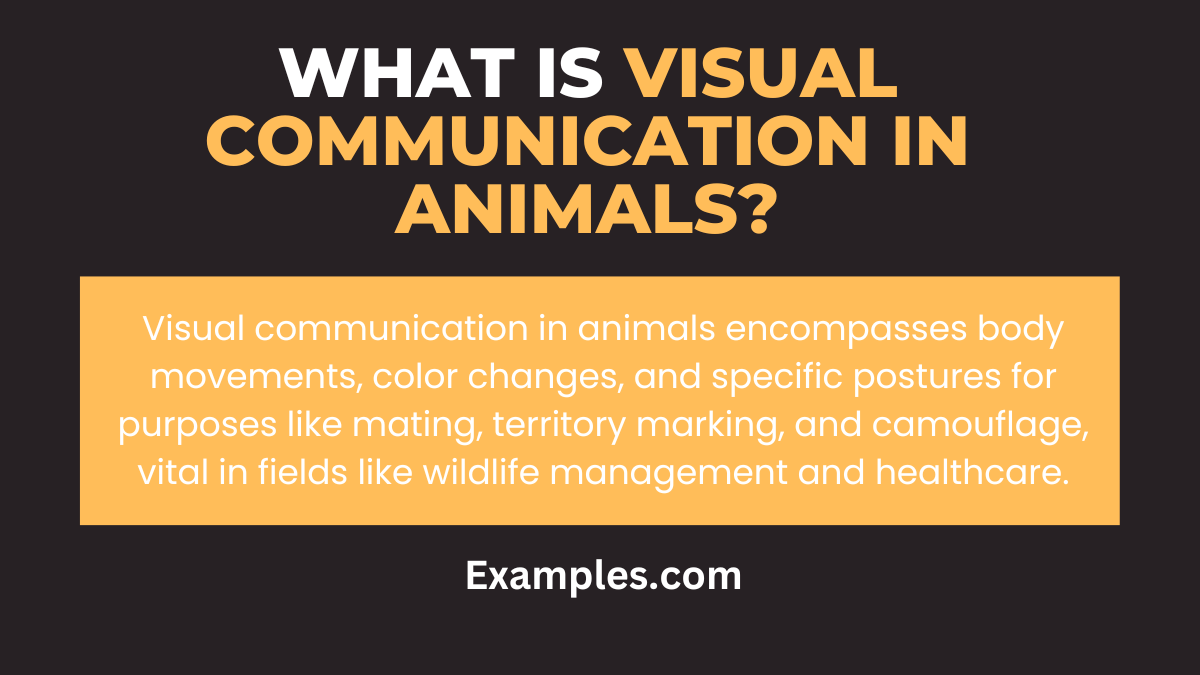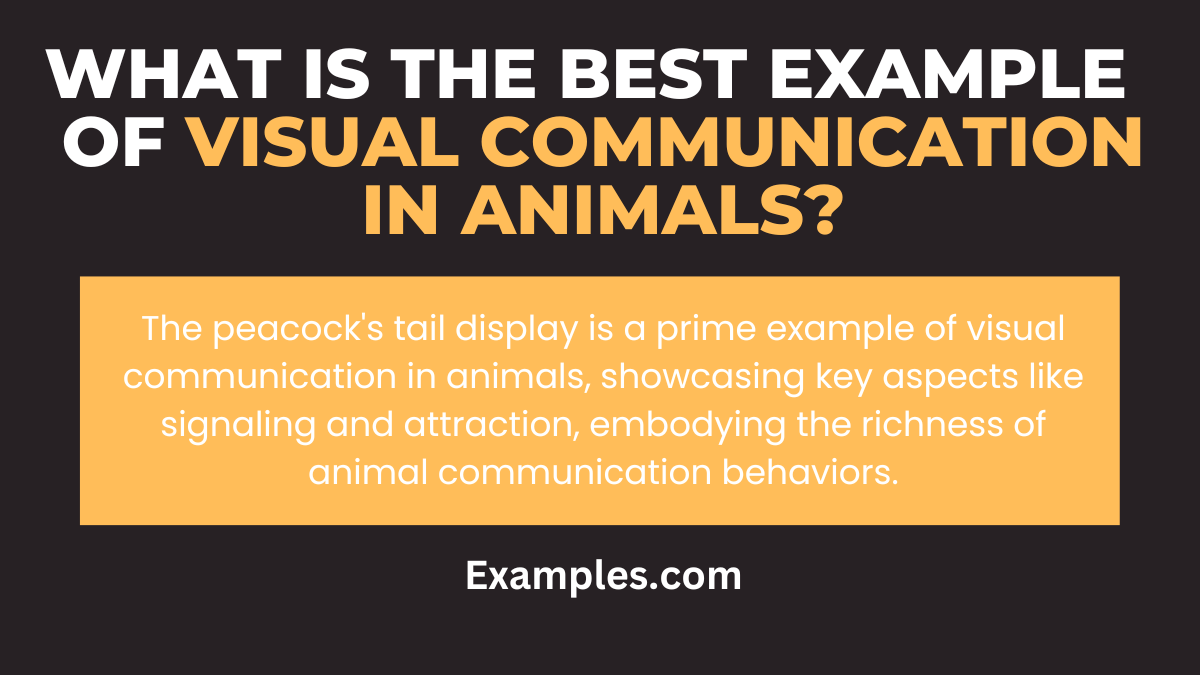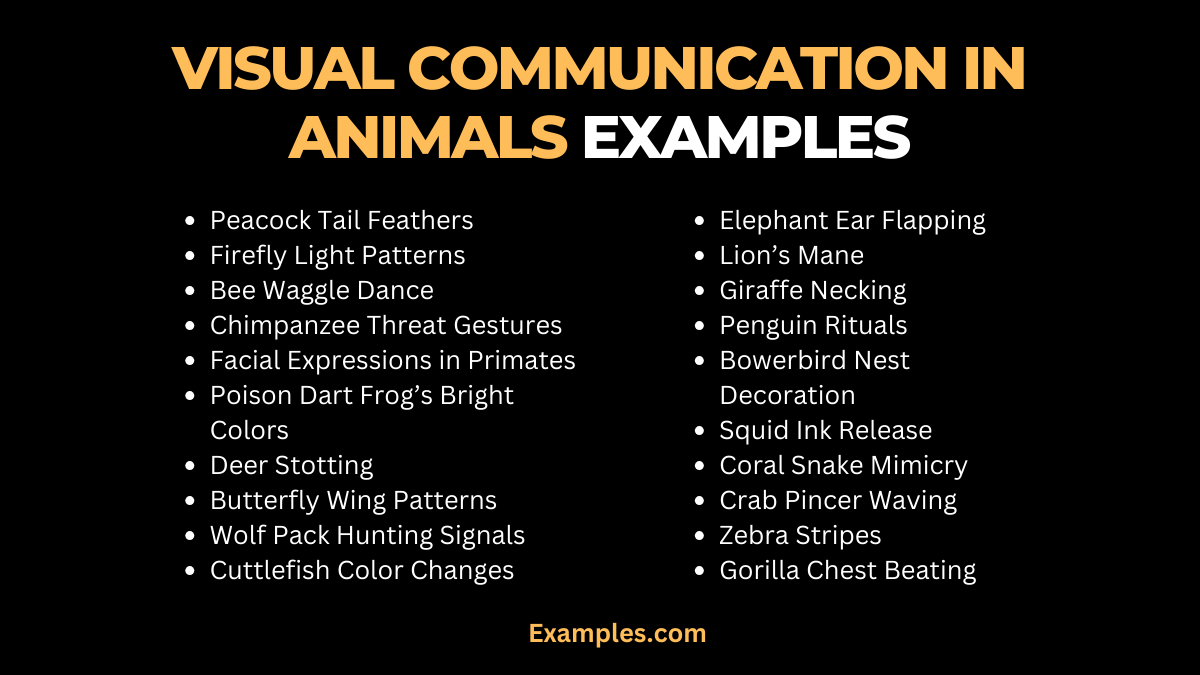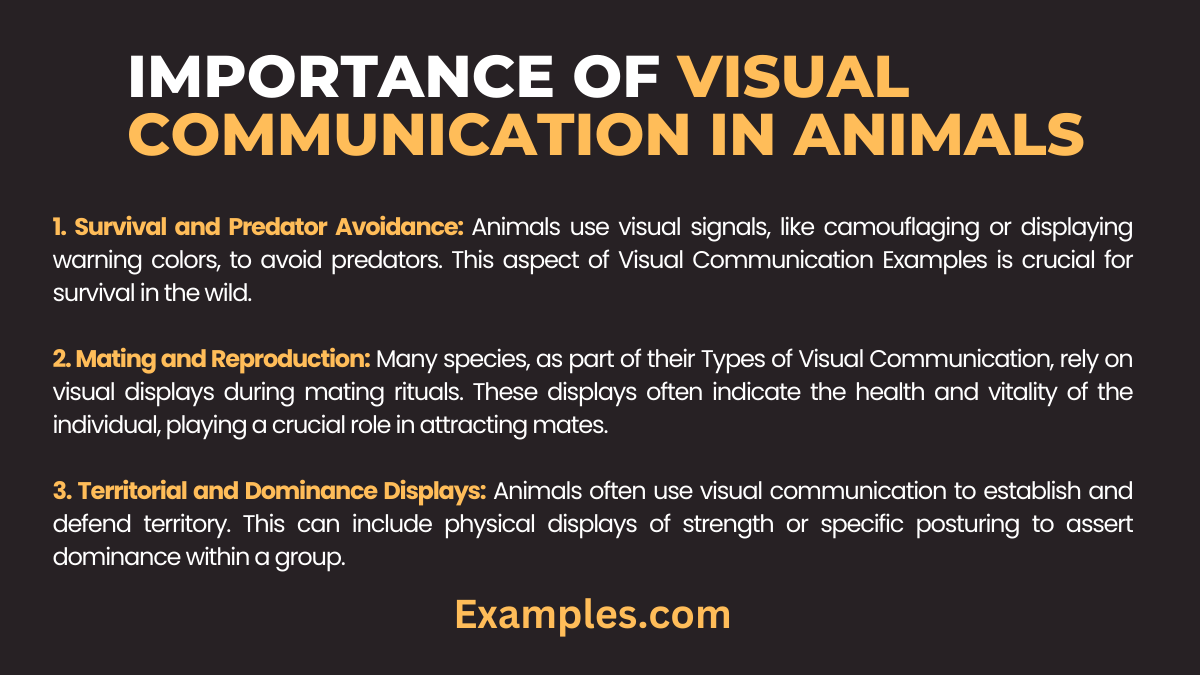19+ Visual Communication in Animals Examples
In this comprehensive guide, we explore the fascinating world of visual communication in animals. Through numerous communication examples, we’ll uncover how animals use visual signals for a range of purposes, from asserting dominance to attracting mates. From the vibrant Animal Coloration Patterns used in camouflage to the intricate Mating Displays in Animal Kingdom, each example highlights the complexity and effectiveness of nonverbal communication in the natural world. This guide offers a deep dive into the various ways animals communicate visually, providing intriguing insights into their behaviors and interactions.
Download Importance of Visual Communication in Animals Examples in PDF
Download Types of Visual Communication in Animals Examples in PDF
What is Visual Communication in Animals?

Visual communication in animals is the process through which animals convey information or express themselves using visual signals, rather than through sounds or scents. This includes a variety of Visual Communication Examples like body movements, changes in coloration, specific postures, or the display of distinctive body parts. Animals use these visual cues for various purposes such as attracting mates, signaling danger, establishing territory, or even camouflaging from predators. Understanding these signals can be crucial in fields like Visual communication in healthcare or Visual communication in the workplace, particularly in zoological and wildlife management contexts. This form of communication is a key part of Types of Visual Communication in the natural world, showcasing the richness and diversity of animal behaviour.
What is the Best Example of Visual Communication in Animals?

A prime example of visual communication in the animal kingdom is the elaborate and striking display of the peacock’s tail feathers. This natural spectacle illustrates several key aspects of visual communication in animals, integrating concepts from Visual Communication Examples and Types of Visual Communication.
The Peacock’s Tail Display
The peacock’s tail display, known for its vibrant colors and eye-catching patterns, is used primarily during mating rituals. The male peacock (peafowl) fans out its large tail to showcase an array of iridescent feathers, each adorned with eye-like patterns known as ocelli. This display is not just a mating call but also a sign of the male’s vitality and genetic quality.
20 Visual Communication in Animals

Visual communication in animals is a diverse and essential aspect of their behavior, crucial for survival, reproduction, and social interactions. This mode of communication, through Visual Communication Examples, utilizes various Types of Visual Communication which are studied extensively in Visual communication journals. Here are 20 distinct examples, showcasing the importance of visual communication and its Characteristics in the animal kingdom:
- Peacock Tail Feathers: Display for mating attraction.
- Firefly Light Patterns: Signal mating readiness.
- Bee Waggle Dance: Indicates nectar location.
- Chimpanzee Threat Gestures: Convey dominance or aggression.
- Facial Expressions in Primates: Show emotions and submissiveness.
- Poison Dart Frog’s Bright Colors: Warn predators of toxicity.
- Deer Stotting: Signal fitness and alert to predators.
- Butterfly Wing Patterns: Camouflage or mimicry for protection.
- Wolf Pack Hunting Signals: Coordinate group hunting strategies.
- Cuttlefish Color Changes: Communication and camouflage.
- Elephant Ear Flapping: Signaling excitement or aggression.
- Lion’s Mane: Indicates health and dominance.
- Giraffe Necking: Combat display for mating rights.
- Penguin Rituals: Bonding and mating communication.
- Bowerbird Nest Decoration: Attract females for mating.
- Squid Ink Release: Escape mechanism from predators.
- Coral Snake Mimicry: Deter predators by mimicking venomous species.
- Crab Pincer Waving: Territorial display or mate attraction.
- Zebra Stripes: Social bonding and predator confusion.
- Gorilla Chest Beating: Demonstrate strength and dominance.
Why is Visual Communication Important in Animals?

Visual communication in animals is an integral aspect of their behavior, essential for survival, reproduction, and social interactions. This form of communication, utilizing visual signals such as body language, coloration, and movement, is critical in the animal kingdom for various reasons.
Key Reasons for the Importance of Visual Communication in Animals
- Survival and Predator Avoidance: Animals use visual signals, like camouflaging or displaying warning colors, to avoid predators. This aspect of Visual Communication Examples is crucial for survival in the wild.
- Mating and Reproduction: Many species, as part of their Types of Visual Communication, rely on visual displays during mating rituals. These displays often indicate the health and vitality of the individual, playing a crucial role in attracting mates.
- Territorial and Dominance Displays: Animals often use visual communication to establish and defend territory. This can include physical displays of strength or specific posturing to assert dominance within a group.
- Social Bonding and Group Coordination: In species that live in groups, visual cues help maintain social order and coordinate group activities. This includes everything from group hunting to migration patterns.
- Conveying Complex Messages Quickly: Visual signals can convey complex messages quickly and effectively, which is essential in situations where immediate response is necessary, such as evading a predator or responding to environmental changes.
- Non-Invasive Communication Across Species: Visual signals can also be a form of non-invasive communication between different species, such as warning signals understood by both predators and prey.
- Facilitating Learning and Development: Young animals often learn social cues and behaviors by observing and mimicking the visual signals of adults, which is a key part of their development.
- Adaptation to Environmental Changes: Visual communication can change in response to environmental factors, allowing animals to adapt their communication strategies for effectiveness in different surroundings.
What are the advantages and disadvantages of visual communications in animals?
Visual communication in animals, while critical for various aspects of their behavior and survival, comes with its own set of advantages and disadvantages. Here’s a comprehensive table that outlines these aspects:
| Advantages | Disadvantages |
|---|---|
| Immediate Impact: Visual signals can be instantly recognized, facilitating quick responses in situations like predator evasion or mating rituals. | Dependence on Visibility: Effectiveness diminishes in poor visibility conditions like darkness or dense foliage. |
| No Sound Required: Ideal in environments where sound communication is hindered or might attract predators. | Energy Consumption: Elaborate visual displays can be energy-intensive, like the peacock’s tail feathers. |
| Non-Invasive Across Species: Can be understood across different species, aiding in broader ecological interactions. | Exposure to Predators: Bright colors or conspicuous displays can make animals more visible to predators. |
| Displays Health and Vitality: In mating, visual cues often indicate an individual’s health, important for natural selection. | Limited to Line of Sight: Unlike auditory signals, visual communication requires the receiver to be in the line of sight. |
| Indicates Emotional States: Subtle visual cues can indicate an animal’s emotional state or intentions to others in their group. | Risk of Misinterpretation: In some cases, visual signals might be misinterpreted by other species or within the same species. |
| Territorial Marking: Visual markers like scratch marks or physical structures can effectively demarcate territory. | Static Nature: Unlike auditory or olfactory signals, visual markers are generally static and cannot follow the sender. |
| Cultural Significance: Certain visual behaviors can be unique to specific animal cultures or groups. | Environmental Limitations: Environmental changes like weather or season can affect the visibility and effectiveness of visual signals. |
| Versatility in Use: Ranges from simple color changes to complex behavioral displays, suitable for various contexts. | Developmental Costs: Development of visual communication features (like antlers) can require significant resources and time. |
| Enhances Group Cohesion: Synchronized movements or displays can strengthen social bonds within a group. | Conflicts with Human Activities: In urban or zoo environments, natural visual communication can be disrupted or misinterpreted. |
This table offers a balanced view of the role and impact of visual communication in the animal kingdom, considering various environmental and biological factors. Understanding these advantages and disadvantages is crucial for comprehensively appreciating the complexity and importance of visual communication in animals, as explored in Visual communication journals and studies?.
What are the Types of Visual Communication in Animals?
Visual communication in animals encompasses a variety of methods and signals used to convey information, express emotions, establish dominance, and more. Understanding these types of visual communication not only enriches our Visual Communication Examples but also provides insights into the Characteristics of visual communication. Here’s a closer look at some of the key types:
1. Coloration and Patterning
- Purpose: Used for camouflage, mate attraction, or warning predators.
- Example: The bright colors of a poison dart frog serve as a warning signal to predators.
- Related to Visual communication in photography where capturing these colors can be crucial.
2. Body Posturing and Gestures
- Purpose: Indicates emotions, intentions, or social status.
- Example: A dominant wolf may exhibit a tall, imposing stance to assert its position.
- Studied in various Visual communication journals for its complexity.
3. Facial Expressions
- Purpose: Convey emotions or responses to environmental stimuli.
- Example: Chimpanzees use facial expressions to show aggression or submission.
- Relevant in understanding how visual communication works in closely related species to humans.
4. Physical Displays
- Purpose: Used in courtship rituals or as a threat display.
- Example: Peacocks fan their colorful tails to attract mates.
- Demonstrates the importance of visual communication in mating rituals.
5. Bioluminescence
- Purpose: Communication in deep-sea environments or nocturnal settings.
- Example: Fireflies use light patterns for mating communication.
- Showcases the adaptation of visual communication skills in different environments.
6. Mimicry
- Purpose: To deceive predators or prey.
- Example: Some butterflies mimic the appearance of other, more dangerous species.
- Explores the Types of Visual Communication used for survival.
7. Territorial Markings
- Purpose: To claim and defend territory.
- Example: Tigers mark their territory with visual signs like scratches on trees.
- Can be related to Visual communication in the workplace where territorial behavior is metaphorically similar.
8. Flocking and Schooling Patterns
- Purpose: For defense and effective foraging.
- Example: Birds and fish move in coordinated patterns for safety and efficiency.
- Offers a unique perspective in Visual communication in healthcare for understanding group dynamics.
9. Seasonal Changes
- Purpose: Indicate readiness for breeding or adapt to environmental changes.
- Example: Certain birds change plumage color during mating seasons.
- Reflects the adaptability aspect in how to use visual communication.
10. Wing Flapping and Dancing
- Purpose: Mostly used in mating displays or to deter predators.
- Example: Birds of paradise perform elaborate dances to attract mates.
- A fascinating subject for those studying Visual communication in animals at zoo.
How do Animals Use Visuals to Communicate?
Animals use visuals like body postures, coloration, and gestures for communication. These signals convey various messages, from mating readiness to territorial warnings.
Why do Animals Understand Eye Contact?
Eye contact in animals often signifies important social cues, such as aggression, threat, or submission. It’s a fundamental aspect of nonverbal communication in many species.
What are the Visual Communication Signs in Animals?
Visual communication signs in animals include color changes, facial expressions, tail movements, and specific postures. These signs convey emotions, intentions, and social status.
In conclusion, visual communication in animals is a rich and diverse field, highlighting the complexity and ingenuity of nature. From the intricate dances of birds of paradise to the subtle gestures of primates, each example provides a glimpse into the sophisticated ways animals interact with their environment and each other. Understanding these visual cues not only fascinates us but also deepens our appreciation of the animal world and its intricate forms of communication.
In the intricate world of animal communication, visual signals play a pivotal role. These signals, ranging from the vibrant plumage of birds to the intricate dances of bees, are not only fascinating but also essential for the survival and reproduction of many species. Understanding this complex language helps us appreciate the rich tapestry of life on Earth and the interconnectedness of all living beings. For a deeper dive into the diverse methods of communication employed by animals, MyLearning.org offers a comprehensive overview, showcasing examples from various species and explaining how these communication strategies have evolved over time.
Furthermore, the study of animal communication provides valuable insights into our own communication methods. By observing how animals use visual cues to convey information, we can gain a better understanding of non-verbal communication and its significance in our daily interactions. The exploration of this subject is not just limited to the animal kingdom but extends to the broader field of communication studies. For an academic perspective on this topic, the publication by Indiana University Press offers an in-depth analysis of animal communication, enriching our knowledge and perspective on this fascinating subject.



